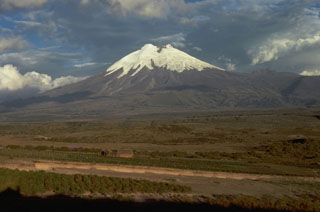Report on Cotopaxi (Ecuador) — 21 December-27 December 2022
Smithsonian Institution / US Geological Survey
Weekly Volcanic Activity Report, 21 December-27 December 2022
Managing Editor: Sally Sennert.
Please cite this report as:
Global Volcanism Program, 2022. Report on Cotopaxi (Ecuador) (Sennert, S, ed.). Weekly Volcanic Activity Report, 21 December-27 December 2022. Smithsonian Institution and US Geological Survey.
Cotopaxi
Ecuador
0.677°S, 78.436°W; summit elev. 5911 m
All times are local (unless otherwise noted)
On 23 December IG issued a special report about increased activity at Cotopaxi. A total of 27 ash emissions had been recorded since the eruption began on 21 October; one ash emission was recorded in October, four were recorded in November, and 22 were recorded by 23 December. Based on Washington VAAC notices, ash clouds drifted the farthest, 60 km NNW, on 26 November and 20 December after rising 2.2 km (the maximum recorded height) and 1.5 km above the crater rim, respectively. Ashfall on those two days was reported in the Mejía, Rumiñahui, and Quito regions. Ash samples from 21 October and 26 November revealed a slight increase in the total percentage of juvenile material; an analysis of 20 December ash was in progress. Increases in sulfur dioxide emissions were measured both by satellite and ground-based Differential Optical Absorption Spectroscopy (DOAS) instruments. Gas measurements taken during periodic overflights showed increases in the ratio of sulfur dioxide to hydrogen sulfide. Based on these and other monitoring data, IG reiterated that the activity was caused by magma in the volcano’s conduit, though not from new magma entering the system after the 2015 eruption.
Daily emissions with ash continued to be observed in webcam images and reported by the Washington VAAC during 23-27 December; weather clouds obscured views on 26 December. Gas-and-steam plumes with low ash content rose as high as 1.5 km above the crater rim and drifted in various directions. Servicio Nacional de Gestión de Riesgos y Emergencias (SNGRE) maintained the Alert Level at Yellow (the second lowest level on a four-color scale).
Geological Summary. The symmetrical, glacier-covered, Cotopaxi stratovolcano is Ecuador's most well-known volcano and one of its most active. The steep-sided cone is capped by nested summit craters, the largest of which is about 550 x 800 m in diameter. Deep valleys scoured by lahars radiate from the summit of the andesitic volcano, and large andesitic lava flows extend to its base. The modern edifice has been constructed since a major collapse sometime prior to about 5,000 years ago. Pyroclastic flows (often confused in historical accounts with lava flows) have accompanied many explosive eruptions, and lahars have frequently devastated adjacent valleys. Strong eruptions took place in 1744, 1768, and 1877. Pyroclastic flows descended all sides of the volcano in 1877, and lahars traveled more than 100 km into the Pacific Ocean and western Amazon basin. Smaller eruptions have been frequent since that time.
Sources: Instituto Geofísico-Escuela Politécnica Nacional (IG-EPN), Servicio Nacional de Gestión de Riesgos y Emergencias (SNGRE)

